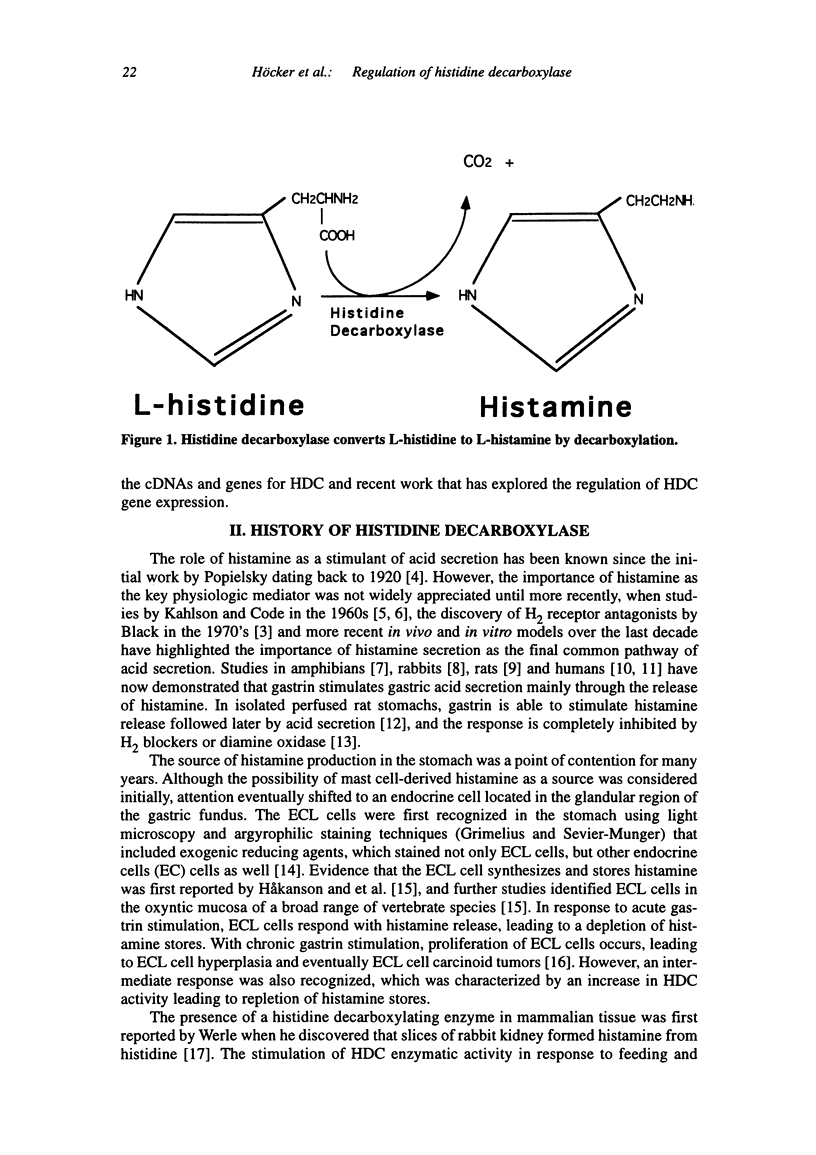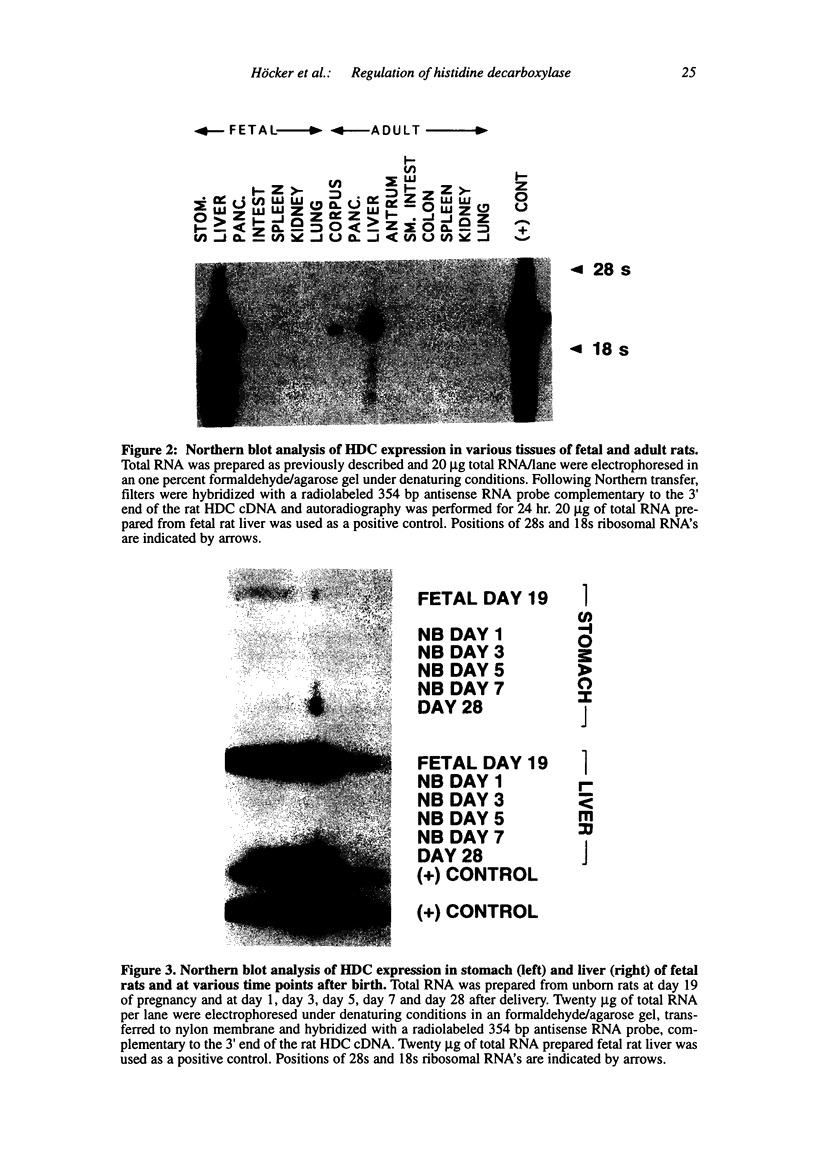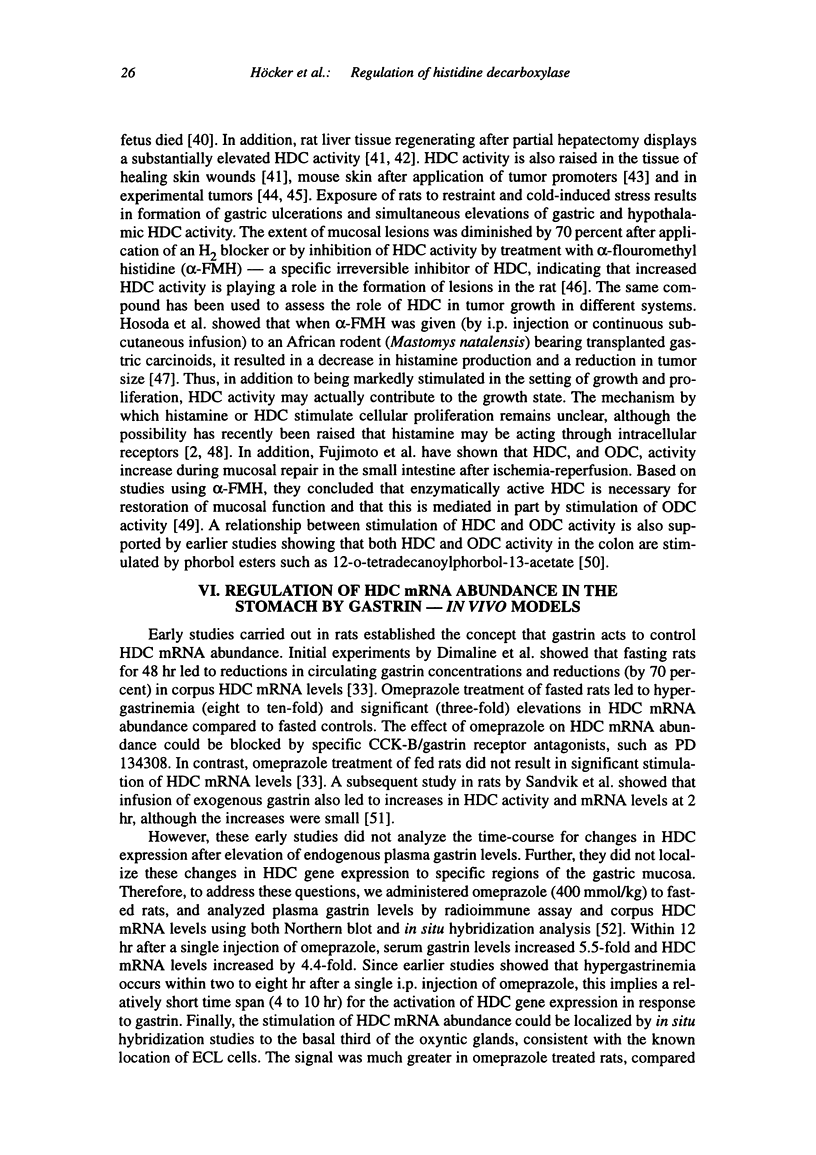Abstract
Histamine is a biogenic amine, which is involved in a variety of biologic processes comprising inflammation, allergic responses, neurotransmission and regulation of gastric acid secretion. The key enzyme for the generation of histamine is histidine decarboxylase (HDC), which converts the amino acid L-histidine to histamine. In this article, we review the history, biochemistry and molecular biology of this enzyme. Northern blot studies in rats demonstrated that HDC gene expression in the stomach and liver are developmentally regulated with highest levels of expression in the late fetal state, indicating a role of the gene in growth and development. In the stomach of adult rats, HDC mRNA levels are elevated after omeprazole-induced hypergastrinemia, and in situ hybridization showed that expression of HDC is restricted to the glandular area in which ECL cells are located. Since no permanent ECL cell line is at hand for in vitro studies, we established a suitable cell system by stable transfection of a human gastric adenocarcinoma cell line (AGS) with the CCK-B/gastrin receptor. Transfection of this AGS-B cell line with reporter gene constructs comprising 5'-flanking DNA sequence of the HDC gene joined to the firefly luciferase gene revealed transcriptional regulation of the HDC promoter by gastrin through a protein-kinase C-dependent pathway. Taken together, these studies are consistent with the concept of HDC transcriptional regulation as at least one phase of the overall response to gastrin.
Full text
PDF












Images in this article
Selected References
These references are in PubMed. This may not be the complete list of references from this article.
- Bartholeyns J., Bouclier M. Involvement of histamine in growth of mouse and rat tumors: antitumoral properties of monofluoromethylhistidine, an enzyme-activated irreversible inhibitor of histidine decarboxylase. Cancer Res. 1984 Feb;44(2):639–645. [PubMed] [Google Scholar]
- Bergqvist E., Obrink K. J. Gastrin-histamine as a normal sequence in gastric acid stimulation in the rabbit. Ups J Med Sci. 1979;84(2):145–154. doi: 10.3109/03009737909179150. [DOI] [PubMed] [Google Scholar]
- Black J. W., Duncan W. A., Durant C. J., Ganellin C. R., Parsons E. M. Definition and antagonism of histamine H 2 -receptors. Nature. 1972 Apr 21;236(5347):385–390. doi: 10.1038/236385a0. [DOI] [PubMed] [Google Scholar]
- Bouclier M., Jung M. J., Gerhart F. Histamine receptor blockade (H2) versus inhibition of histamine synthesis in stress ulceration in rats. Eur J Pharmacol. 1983 May 20;90(1):129–132. doi: 10.1016/0014-2999(83)90224-8. [DOI] [PubMed] [Google Scholar]
- Brandes L. J., LaBella F. S., Glavin G. B., Paraskevas F., Saxena S. P., McNicol A., Gerrard J. M. Histamine as an intracellular messenger. Biochem Pharmacol. 1990 Oct 15;40(8):1677–1681. doi: 10.1016/0006-2952(90)90341-h. [DOI] [PubMed] [Google Scholar]
- Cattan D., Roucayrol A. M., Launay J. M., Callebert J., Charasz N., Nurit Y., Belaiche J., Kalifat R. Circulating gastrin, endocrine cells, histamine content, and histidine decarboxylase activity in atrophic gastritis. Gastroenterology. 1989 Sep;97(3):586–596. doi: 10.1016/0016-5085(89)90628-8. [DOI] [PubMed] [Google Scholar]
- Code C. F. Histamine and gastric secretion: a later look, 1955-1965. Fed Proc. 1965 Nov-Dec;24(6):1311–1321. [PubMed] [Google Scholar]
- Dale H. H., Laidlaw P. P. The physiological action of beta-iminazolylethylamine. J Physiol. 1910 Dec 31;41(5):318–344. doi: 10.1113/jphysiol.1910.sp001406. [DOI] [PMC free article] [PubMed] [Google Scholar]
- Dimaline R., Sandvik A. K. Histidine decarboxylase gene expression in rat fundus is regulated by gastrin. FEBS Lett. 1991 Apr 9;281(1-2):20–22. doi: 10.1016/0014-5793(91)80348-7. [DOI] [PubMed] [Google Scholar]
- Ekblad E. B. Histamine: the sole mediator of pentagastrin-stimulated acid secretion. Acta Physiol Scand. 1985 Sep;125(1):135–143. doi: 10.1111/j.1748-1716.1985.tb07700.x. [DOI] [PubMed] [Google Scholar]
- Fujimoto K., Imamura I., Granger D. N., Wada H., Sakata T., Tso P. Histamine and histidine decarboxylase are correlated with mucosal repair in rat small intestine after ischemia-reperfusion. J Clin Invest. 1992 Jan;89(1):126–133. doi: 10.1172/JCI115552. [DOI] [PMC free article] [PubMed] [Google Scholar]
- Grzanna R. Histidine decarboxylase: isolation and molecular characteristics. Neurochem Res. 1984 Jul;9(7):993–1009. doi: 10.1007/BF00964529. [DOI] [PubMed] [Google Scholar]
- Hammar L., Hjertén S. Mammalian histidine decarboxylase; changes in molecular properties induced by oxidation and reduction. Agents Actions. 1980 Apr;10(1 Pt 2):93–98. doi: 10.1007/BF02024185. [DOI] [PubMed] [Google Scholar]
- Hollande F., Bali J. P., Magous R. Neurohormonal regulation of histamine synthesis in isolated rabbit fundic mucosal cells. Am J Physiol. 1994 Mar;266(3 Pt 1):G395–G402. doi: 10.1152/ajpgi.1994.266.3.G395. [DOI] [PubMed] [Google Scholar]
- Hosoda S., Saito T., Kumazawa H., Watanabe T., Wada H. Marked inhibition of histamine formation in transplantable histamine-producing gastric carcinoid of Mastomys natalensis by (S)-alpha-fluoromethylhistidine and its potent antiulcer effect on tumor-bearing hosts. Biochem Pharmacol. 1985 Dec 15;34(24):4327–4329. doi: 10.1016/0006-2952(85)90293-x. [DOI] [PubMed] [Google Scholar]
- Huszti Z., Magyar K., Keleti J. Possible regulation of hypothalamus and lung histidine decarboxylase activity by cAMP-dependent protein kinase. Eur J Biochem. 1991 Apr 10;197(1):191–196. doi: 10.1111/j.1432-1033.1991.tb15898.x. [DOI] [PubMed] [Google Scholar]
- Håkanson R., Böttcher G., Ekblad E., Panula P., Simonsson M., Dohlsten M., Hallberg T., Sundler F. Histamine in endocrine cells in the stomach. A survey of several species using a panel of histamine antibodies. Histochemistry. 1986;86(1):5–17. doi: 10.1007/BF00492340. [DOI] [PubMed] [Google Scholar]
- Håkanson R., Sundler F. Trophic effects of gastrin. Scand J Gastroenterol Suppl. 1991;180:130–136. doi: 10.3109/00365529109093190. [DOI] [PubMed] [Google Scholar]
- Imanishi N., Nakayama T., Asano M., Yatsunami K., Tomita K., Ichikawa A. Induction of histidine decarboxylase by dexamethasone in mastocytoma P-815 cells. Biochim Biophys Acta. 1987 Apr 22;928(2):227–234. doi: 10.1016/0167-4889(87)90125-x. [DOI] [PubMed] [Google Scholar]
- Imanishi N., Ohmori E., Yatsunami K., Ichikawa A. Effect of hydrocortisone on histidine decarboxylase activity in rat stomach. Chem Pharm Bull (Tokyo) 1988 Oct;36(10):4088–4094. doi: 10.1248/cpb.36.4088. [DOI] [PubMed] [Google Scholar]
- Ishikawa E., Toki A., Moriyama T., Matsuoka Y., Aikawa T., Suda M. A study on the induction of histidine decarboxylase in tumor-bearing rat. J Biochem. 1970 Sep;68(3):347–358. doi: 10.1093/oxfordjournals.jbchem.a129365. [DOI] [PubMed] [Google Scholar]
- Ito M., Matsui T., Taniguchi T., Tsukamoto T., Murayama T., Arima N., Nakata H., Chiba T., Chihara K. Functional characterization of a human brain cholecystokinin-B receptor. A trophic effect of cholecystokinin and gastrin. J Biol Chem. 1993 Aug 25;268(24):18300–18305. [PubMed] [Google Scholar]
- Joseph D. R., Sullivan P. M., Wang Y. M., Kozak C., Fenstermacher D. A., Behrendsen M. E., Zahnow C. A. Characterization and expression of the complementary DNA encoding rat histidine decarboxylase. Proc Natl Acad Sci U S A. 1990 Jan;87(2):733–737. doi: 10.1073/pnas.87.2.733. [DOI] [PMC free article] [PubMed] [Google Scholar]
- KAHLSON G., ROSENGREN E. Prevention of foetal development by enzyme inhibition. Nature. 1959 Oct 17;184(Suppl 16):1238–1239. doi: 10.1038/1841238a0. [DOI] [PubMed] [Google Scholar]
- KAHLSON G., ROSENGREN E., SVAHN D., THUNBERG R. MOBILIZATION AND FORMATION OF HISTAMINE IN THE GASTRIC MUCOSA AS RELATED TO ACID SECRETION. J Physiol. 1964 Nov;174:400–416. doi: 10.1113/jphysiol.1964.sp007494. [DOI] [PMC free article] [PubMed] [Google Scholar]
- Kahlson G., Rosengren E. Histamine: entering physiology. Experientia. 1972 Sep 15;28(9):993–1002. doi: 10.1007/BF01918636. [DOI] [PubMed] [Google Scholar]
- Kahlson G., Rosengren E. New approaches to the physiology of histamine. Physiol Rev. 1968 Jan;48(1):155–196. doi: 10.1152/physrev.1968.48.1.155. [DOI] [PubMed] [Google Scholar]
- Kawai H., Ohgoh M., Emoto S., Ohmori E., Imanishi N., Yatsunami K., Ichikawa A. Synergistic effects of 12-O-tetradecanoylphorbol-13-acetate and dexamethasone on de novo synthesis of histidine decarboxylase in mouse mastocytoma P-815 cells. Biochim Biophys Acta. 1992 Jan 13;1133(2):172–178. doi: 10.1016/0167-4889(92)90066-k. [DOI] [PubMed] [Google Scholar]
- Lee Y. M., Beinborn M., McBride E. W., Lu M., Kolakowski L. F., Jr, Kopin A. S. The human brain cholecystokinin-B/gastrin receptor. Cloning and characterization. J Biol Chem. 1993 Apr 15;268(11):8164–8169. [PubMed] [Google Scholar]
- Lundell L. The role of cholinergic excitation in the formation of histamine within the rat gastric mucosa. Acta Physiol Scand. 1976 Jun;97(2):145–149. doi: 10.1111/j.1748-1716.1976.tb10246.x. [DOI] [PubMed] [Google Scholar]
- Lönroth H., Rosengren E., Olbe L., Lundell L. Histamine metabolism in human gastric mucosa. Effect of pentagastrin stimulation. Gastroenterology. 1990 Apr;98(4):921–928. doi: 10.1016/0016-5085(90)90016-t. [DOI] [PubMed] [Google Scholar]
- Maeyama K., Taguchi Y., Sasaki M., Wada H., Beaven M. A., Watanabe T. Induction of histidine decarboxylase of rat basophilic leukemia (2H3) cells stimulated by higher oligomeric IgE or phorbol myristate acetate. Biochem Biophys Res Commun. 1988 Mar 30;151(3):1402–1407. doi: 10.1016/s0006-291x(88)80518-7. [DOI] [PubMed] [Google Scholar]
- Mamune-Sato R., Tanno Y., Maeyama K., Miura Y., Takishima T., Kishi K., Fukuda T., Watanabe T. Histidine decarboxylase in human basophilic leukemia (KU-812-F) cells. Characterization and induction by phorbol myristate acetate. Biochem Pharmacol. 1990 Sep 1;40(5):1125–1129. doi: 10.1016/0006-2952(90)90502-c. [DOI] [PubMed] [Google Scholar]
- Mamune-Sato R., Yamauchi K., Tanno Y., Ohkawara Y., Ohtsu H., Katayose D., Maeyama K., Watanabe T., Shibahara S., Takishima T. Functional analysis of alternatively spliced transcripts of the human histidine decarboxylase gene and its expression in human tissues and basophilic leukemia cells. Eur J Biochem. 1992 Oct 15;209(2):533–539. doi: 10.1111/j.1432-1033.1992.tb17317.x. [DOI] [PubMed] [Google Scholar]
- Man W. K., Ingoldby C. J., Spencer J. Is pentagastrin-stimulated secretion mediated by histamine? Gut. 1984 Sep;25(9):965–970. doi: 10.1136/gut.25.9.965. [DOI] [PMC free article] [PubMed] [Google Scholar]
- Miyazaki T., Ohgoh M., Ohmori E., Yamamoto J., Emoto S., Yatsunami K., Ichikawa A. Synergistic effects of cyclic AMP and Ca2+ ionophore A23187 on de novo synthesis of histidine decarboxylase in mastocytoma P-815 cells. Biochim Biophys Acta. 1992 Jan 13;1133(2):179–186. doi: 10.1016/0167-4889(92)90067-l. [DOI] [PubMed] [Google Scholar]
- Miyazaki Y., Imamura I., Shinomura Y., Wada H., Tarui S. Marked increase in gastric histidine decarboxylase activity in patients with hypergastrinemia. Life Sci. 1991;48(1):51–58. doi: 10.1016/0024-3205(91)90424-a. [DOI] [PubMed] [Google Scholar]
- Ohmori E., Imanishi N., Ohgoh M., Fukui T., Ichikawa A. Fluctuation of fetal rat hepatic histidine decarboxylase activity through the glucocorticoid-ACTH system. Biochem Pharmacol. 1991 Mar 1;41(5):844–847. doi: 10.1016/0006-2952(91)90092-j. [DOI] [PubMed] [Google Scholar]
- Prinz C., Scott D. R., Hurwitz D., Helander H. F., Sachs G. Gastrin effects on isolated rat enterochromaffin-like cells in primary culture. Am J Physiol. 1994 Oct;267(4 Pt 1):G663–G675. doi: 10.1152/ajpgi.1994.267.4.G663. [DOI] [PubMed] [Google Scholar]
- Sandvik A. K., Dimaline R., Mårvik R., Brenna E., Waldum H. L. Gastrin regulates histidine decarboxylase activity and mRNA abundance in rat oxyntic mucosa. Am J Physiol. 1994 Aug;267(2 Pt 1):G254–G258. doi: 10.1152/ajpgi.1994.267.2.G254. [DOI] [PubMed] [Google Scholar]
- Sandvik A. K., Waldum H. L., Kleveland P. M., Schulze Søgnen B. Gastrin produces an immediate and dose-dependent histamine release preceding acid secretion in the totally isolated, vascularly perfused rat stomach. Scand J Gastroenterol. 1987 Sep;22(7):803–808. doi: 10.3109/00365528708991918. [DOI] [PubMed] [Google Scholar]
- Savany A., Cronenberger L. Isolation and properties of multiple forms of histidine decarboxylase from rat gastric mucosa. Biochem J. 1982 Aug 1;205(2):405–412. doi: 10.1042/bj2050405. [DOI] [PMC free article] [PubMed] [Google Scholar]
- Savany A., Cronenberger L. Relationship between the multiple forms of rat gastric histidine decarboxylase: effects of conditions favouring phosphorylation and dephosphorylation. Biochem Int. 1990;20(2):363–374. [PubMed] [Google Scholar]
- Solcia E., Capella C., Vassallo G., Buffa R. Endocrine cells of the gastric mucosa. Int Rev Cytol. 1975;42:223–286. doi: 10.1016/s0074-7696(08)60982-1. [DOI] [PubMed] [Google Scholar]
- Sun Y., Li Y. Induction of ornithine decarboxylase and histidine decarboxylase activities in rat colon mucosa after application of 12-o-tetradecanoylphorbol-13-acetate (TPA), sodium deoxycholate and indole. Cancer Lett. 1988 Feb;39(1):77–84. doi: 10.1016/0304-3835(88)90042-0. [DOI] [PubMed] [Google Scholar]
- Taguchi Y., Watanabe T., Kubota H., Hayashi H., Wada H. Purification of histidine decarboxylase from the liver of fetal rats and its immunochemical and immunohistochemical characterization. J Biol Chem. 1984 Apr 25;259(8):5214–5221. [PubMed] [Google Scholar]
- Watanabe T., Kitamura Y., Maeyama K., Go S., Yamatodani A., Wada H. Absence of increase of histidine decarboxylase activity in mast cell-deficient W/W mouse embryos before parturition. Proc Natl Acad Sci U S A. 1981 Jul;78(7):4209–4212. doi: 10.1073/pnas.78.7.4209. [DOI] [PMC free article] [PubMed] [Google Scholar]
- Watanabe T., Nakamura H., Liang L. Y., Yamatodani A., Wada H. Partial purification and characterization of L-histidine decarboxylase from fetal rats. Biochem Pharmacol. 1979 Apr 1;28(7):1149–1155. doi: 10.1016/0006-2952(79)90321-6. [DOI] [PubMed] [Google Scholar]
- Watanabe T., Taguchi Y., Sasaki K., Tsuyama K., Kitamura Y. Increase in histidine decarboxylase activity in mouse skin after application of the tumor promoter tetradecanoylphorbol acetate. Biochem Biophys Res Commun. 1981 May 15;100(1):427–432. doi: 10.1016/s0006-291x(81)80114-3. [DOI] [PubMed] [Google Scholar]
- Yamamoto J., Yatsunami K., Ohmori E., Sugimoto Y., Fukui T., Katayama T., Ichikawa A. cDNA-derived amino acid sequence of L-histidine decarboxylase from mouse mastocytoma P-815 cells. FEBS Lett. 1990 Dec 10;276(1-2):214–218. doi: 10.1016/0014-5793(90)80545-t. [DOI] [PubMed] [Google Scholar]
- Yamauchi K., Sato R., Tanno Y., Ohkawara Y., Maeyama K., Watanabe T., Satoh K., Yoshizawa M., Shibahara S., Takishima T. Nucleotide sequence of the cDNA encoding L-histidine decarboxylase derived from human basophilic leukemia cell line, KU-812-F. Nucleic Acids Res. 1990 Oct 11;18(19):5891–5891. doi: 10.1093/nar/18.19.5891. [DOI] [PMC free article] [PubMed] [Google Scholar]
- Yassin R. R., Clearfield H. R., Little K. M. Gastrin's trophic effect in the colon: identification of a signaling pathway mediated by protein kinase C. Peptides. 1993 Nov-Dec;14(6):1119–1124. doi: 10.1016/0196-9781(93)90164-c. [DOI] [PubMed] [Google Scholar]
- Zahnow C. A., Yi H. F., McBride O. W., Joseph D. R. Cloning of the cDNA encoding human histidine decarboxylase from an erythroleukemia cell line and mapping of the gene locus to chromosome 15. DNA Seq. 1991;1(6):395–400. doi: 10.3109/10425179109020795. [DOI] [PubMed] [Google Scholar]





